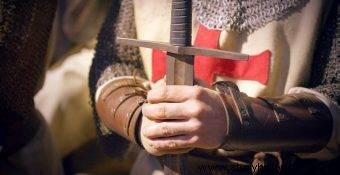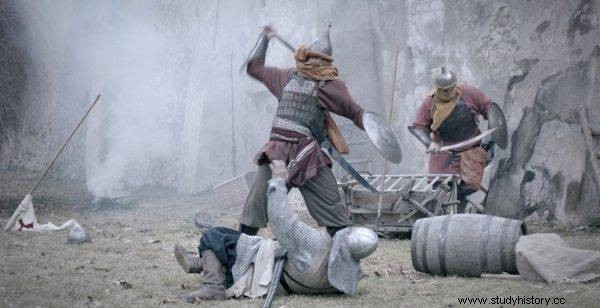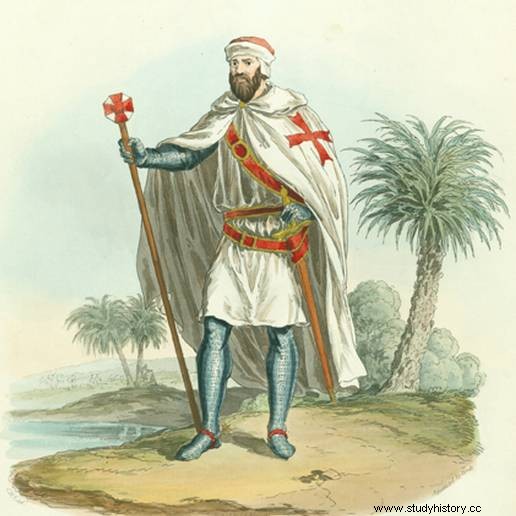"Each of you has made a vow of poverty, renouncing personal property, but as a religious community you want to have everything," thundered Bishop of Acre Jacques de Vitry, outraged by the lack of moderation in the conquest of the earthly goods by the Poor Knights of Christ. Indeed, the fortune raised the Templars to unprecedented power, but also brought a tragic end to them.
The Knights Templar was one of the most mysterious religious orders of the Middle Ages. These knights in habits were repeatedly accused of witchcraft, profanation, debauchery, worshiping Satan or allying with infidels. As if that were not enough, they were also accused of keeping one of the greatest treasures of the Christian world - the Holy Grail.
In the pursuit of sensation, however, it is often forgotten that they laid the foundations of today's banking system, bravely stood against the Saracens on the Iberian Peninsula and fought the Mongols in the Battle of Legnica in 1241. As monks who were forbidden by the rule to redeem prisoners, they could not count on the mercy of their opponents. "The Templar can only offer his belt and dagger as ransom" Said one of the masters of the order, dying in Saracen captivity.

The Knights Templar was one of the most mysterious religious congregations of the Middle Ages
Historians estimate that in less than 200 years of the order's existence, about 20,000 people died or were brutally killed. knights. They had great achievements, but they paid an enormous tribute of blood - especially if you look at their humble beginnings.
In the East… changes needed
Admittedly, the Templars always had a nose for business and were able to seize every opportunity. It was no different with the formation of this armed brotherhood. In this case, a favorable circumstance was the crusade movement, which forever changed the face of the contemporary world.
The success of the first expedition and the conquest of Jerusalem in 1099 did not settle the matter of permanent Christian rule in the Holy Land. The initial momentum and enthusiasm of the European knighthood quickly began to diminish, and there were problems with keeping what had been obtained . Many of the leaders and participants of the first uprising were either dead or old, and at best wanted to return to their homes and families in Europe.
The chronicles say that soon after the conquest of the Holy City, only 300 knights and as many walkers remained nearby. Meanwhile, the constant danger of Muslim retaliation required the creation and (most importantly) maintenance of a military force capable of effective combat. The local mass movement was no longer enough - even the bravest one. The city wards, which were used temporarily or by church dignitaries, did not help either.

The rulers of the Kingdom of Jerusalem were forced to use mercenary troops. They were recruited from among the pilgrims whose new wave began to flow in from Europe. For pay (or participation in spoils) in the defense of holy places were therefore feudal lords making a penitential journey to Jerusalem, knights seeking adventures, and ordinary adventurers. Most, however, were troops made up of local volunteers. Most often, these forces manned the city garrisons and performed guard and police functions.
Despite the fact that the participation of mercenaries in the army of the Kingdom of Jerusalem continued to increase, they could not satisfy the constant deficit. In fact during the first decades of its existence the Crusader state was mainly concerned with ... the struggle for survival. The care of the treasures of Christianity entrusted to them was relegated to the background, and one of the chroniclers wrote about the situation of pilgrims:
And when from all parts of the world the rich and the poor, girls and boys, old men and children, rushed to Jerusalem to visit the Holy Places, robbers and robbers harassed them on the way, by surprising the pilgrims, they plundered a great many and murdered many.
New solutions were needed, and fast.
Serve and protect
In this situation, the Christian world had to accept the appearance of Hugo de Payns on the historical scene with great joy. Little is known about this knight from Champagne. Sources only say that he was elderly. This, however, absolutely did not prevent him from being brave, pious and sensitive to the misery of his fellow man.
He knew the way to Jerusalem, so he was well aware to what dangers pilgrims are exposed to and how ineffective the crusaders are in protecting them . As a noble defender of the Holy Sepulcher, he decided to do something about it. In 1118 (although some historians postpone this date by two years), Hugh and eight companions, as reported by the chronicler:
They have renounced the world and consecrated to Christ. In solemn vows made before the Patriarch of Jerusalem, they undertook to defend the pilgrims from robbers and captors, protect the roads and serve as knights to the High King.
According to fragmentary accounts from the early days of the fraternity, it is known that its members maintained poverty, chastity and obedience according to the rule of regular canons. They served in secular clothing, covering themselves with what they received from the faithful.
The road to power
These humble beginnings were quickly forgotten. King Baldwin II, filled with "compassion for those noble men who had abandoned everything to serve Christ", gave them to the headquarters part of his palace in Jerusalem, near the mosque al-Aqsa, the former temple of Solomon ( templum Solomonis - hence they began to be called temple knights, militia templi , that is, the Templars).
In addition, the abbot of the Lord's Temple and the canons gave for their needs the land near the palace. It was the first stone that soon started a real avalanche of donations and endowments for the poor in the founding of the fraternity.
Its creation undoubtedly filled a painful gap in the internal organization of the Kingdom of Jerusalem. Activities of a police and orderly nature relieved the fragile forces of the crusaders from dealing with problems related to the internal security of the country . For this reason, Hugh and his companions quickly gained recognition and support not only of rulers, but also of the powerful and ecclesiastical dignitaries.
Soon steps were taken to make it ad hoc transform the group into an organization of a permanent nature, with its own rule - in a word, it was to be a lawful order, recognized and approved by the papacy.
An uninterrupted stream of riches
The highly respected Bernard of Clairvaux was an ardent advocate of the formation of the new congregation. It was, among other things, thanks to his strenuous efforts during the synod of Troyes that the Templars "in the year of our Lord 1128, having lived nine years in community and holy poverty in accordance with their vows, received the (Cistercian) rule through the solicitude of Pope Honorius and Stephen, Patriarch of Jerusalem, and appointed them as white habit outfit ”.
Temple knights were then to take in addition to the three customary vows - poverty, obedience, and chastity - another to fight the infidels. Soon, with the permission of Pope Eugene III, "they sewed a red cross on their habits, wearing white as a symbol of purity, and red as a symbol of martyrdom." 
With the sanctioning of the order, the stream of riches flowing to it only grew stronger. The godly work of fighting in the name of Christ attracted to the ranks of the brotherhood of the powerful of the then world, whose fortunes increased the possession of not so poor knights.
It soon turned out that the new order was a tasty morsel in the internal games of the Latin nation. King Baldwin II, counting on the combat experience of his brother knights, probably expected that they would be the nucleus of a stable and well-organized army at his service. In turn, the patriarch made plans to use warriors in habits to transform the Kingdom of Jerusalem into an ecclesiastical state (with it, of course, as ruler).
The future showed that the Templars had their own idea of life. The Order quickly became an institution independent not only of the king and patriarch, but also of all the rulers of Europe - including the Pope himself.
